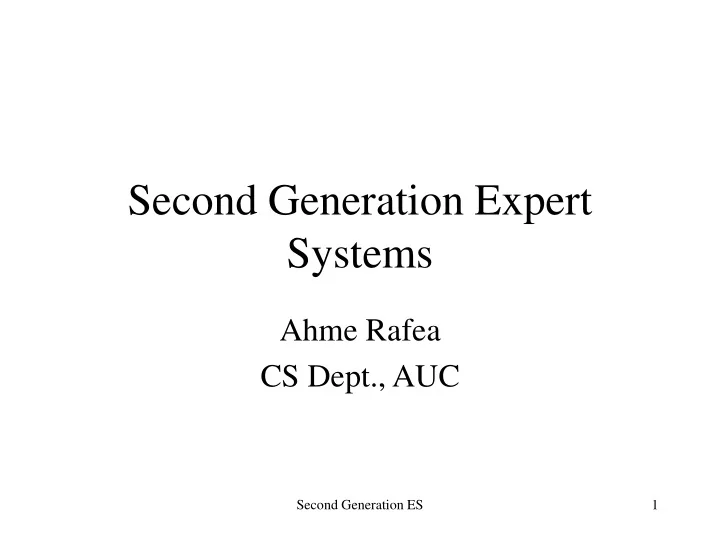

Second Generation Expert Systems Ahme Rafea CS Dept., AUC Second Generation ES 1
First Generation ES Problems • Knowledge Acquisition • Explanation • Brittleness • KB Maintenance Second Generation ES 2
Multiple Domain Knowledge Models • Multiple Domain Models – Different Representation – Deep Knowledge – Qualitative Reasoning – Different Level (e.g. diseases, anatomy,…) – Different Points of View(e.g. Structural and Functional) Second Generation ES 3
Multiple Methods • Specialized to a particular Representation • Specialized for a particular subtask • Combine multiple models and methods • There are many criteria for choosing a problem-solving architecture • Domain Analysis is needed to choose the problem-solving architecture Second Generation ES 4
Knowledge Level • Distinction between Knowledge Level and Implementation Level • Describing the problem-solving process in more abstract terms such as classification, data abstraction, abduction, etc. • Emphasizing how the problem will be solved rather that how the system will be implemented • Provides guidance in Knowledge Acquisition • Reuse of Generic Constructs • More abstract Explanation Second Generation ES 5
KL Different Approaches • Role Limiting Method, putting emphasis on methods • Generic Task is a method oriented approach(Limited set of Primitive Constructs) • KADS places emphasis on Task (general modeling Language) • Model Based Reasoning puts emphasis on Domain Model Second Generation ES 6
Second Generation Expert Systems • Knowledge Acquisition • Explanation • Robustness and Efficiency • Reusability Second Generation ES 7
Knowledge Acquisition • Modeling • Instantiating the Model • Validation • Open Issues and On-going Work – Development of the model and acquisition of domain knowledge may be interleaved – Selecting the appropriate model may not be easy Second Generation ES 8
Explanation • Explaining at the right level of abstraction – The Task structure and the domain model provide the basis for more abstract explanation • Re-constructive Explanation – One KBS (performance system) is used to solve the problem, then conclusion of this system is passed to a second system (the explanation system) that justifies(and thus explains ) the conclusion • Open Issues – Producing explanation in natural language – Adapting the explanation to user needs – Managing the dialogue Second Generation ES 9
Robustness and Efficiency • Multiple Knowledge Sources – Representing sufficient knowledge, improve the robustness of the system – Efficiency increases because only necessary knowledge is processed • Multiple Representation – Specialized representation, tuned to particular types of knowledge can make certain inferences very tractable • Open Issues – Difficulties in integrating diverse knowledge sources and representations Second Generation ES 10
Reusability • Reusing Knowledge-Level models • Reusing Knowledge bases • Reusing Symbol-level Components Second Generation ES 11
Recommend
More recommend